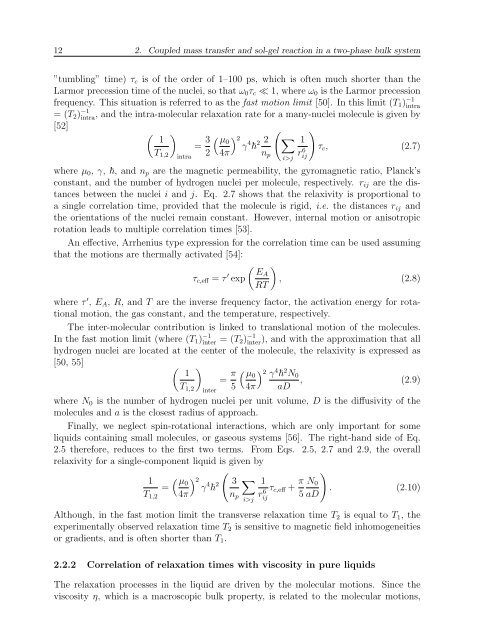Untitled - Technische Universiteit Eindhoven
Untitled - Technische Universiteit Eindhoven
Untitled - Technische Universiteit Eindhoven
- No tags were found...
Create successful ePaper yourself
Turn your PDF publications into a flip-book with our unique Google optimized e-Paper software.
12 2. Coupled mass transfer and sol-gel reaction in a two-phase bulk system”tumbling” time) τ c is of the order of 1–100 ps, which is often much shorter than theLarmor precession time of the nuclei, so that ω 0 τ c ≪ 1, where ω 0 is the Larmor precessionfrequency. This situation is referred to as the fast motion limit [50]. In this limit (T 1 ) −1intra= (T 2 ) −1intra , and the intra-molecular relaxation rate for a many-nuclei molecule is given by[52]( 1T 1,2)intra= 3 2(( µ0) 2γ 4 2 2 ∑4π n pi>j1r 6 ij)τ c , (2.7)where µ 0 , γ, , and n p are the magnetic permeability, the gyromagnetic ratio, Planck’sconstant, and the number of hydrogen nuclei per molecule, respectively. r ij are the distancesbetween the nuclei i and j. Eq. 2.7 shows that the relaxivity is proportional toa single correlation time, provided that the molecule is rigid, i.e. the distances r ij andthe orientations of the nuclei remain constant. However, internal motion or anisotropicrotation leads to multiple correlation times [53].An effective, Arrhenius type expression for the correlation time can be used assumingthat the motions are thermally activated [54]:( )τ c,eff = τ ′ EAexp , (2.8)RTwhere τ ′ , E A , R, and T are the inverse frequency factor, the activation energy for rotationalmotion, the gas constant, and the temperature, respectively.The inter-molecular contribution is linked to translational motion of the molecules.In the fast motion limit (where (T 1 ) −1inter = (T 2) −1inter ), and with the approximation that allhydrogen nuclei are located at the center of the molecule, the relaxivity is expressed as[50, 55] ( 1=T 1,2)inter π ( µ0) 2 γ 4 2 N 05 4π aD , (2.9)where N 0 is the number of hydrogen nuclei per unit volume, D is the diffusivity of themolecules and a is the closest radius of approach.Finally, we neglect spin-rotational interactions, which are only important for someliquids containing small molecules, or gaseous systems [56]. The right-hand side of Eq.2.5 therefore, reduces to the first two terms. From Eqs. 2.5, 2.7 and 2.9, the overallrelaxivity for a single-component liquid is given by1T 1,2=(( µ0) 2γ 4 2 3 ∑4π n pi>j1τrij 6 c,eff + π N 05 aD). (2.10)Although, in the fast motion limit the transverse relaxation time T 2 is equal to T 1 , theexperimentally observed relaxation time T 2 is sensitive to magnetic field inhomogeneitiesor gradients, and is often shorter than T 1 .2.2.2 Correlation of relaxation times with viscosity in pure liquidsThe relaxation processes in the liquid are driven by the molecular motions. Since theviscosity η, which is a macroscopic bulk property, is related to the molecular motions,
















